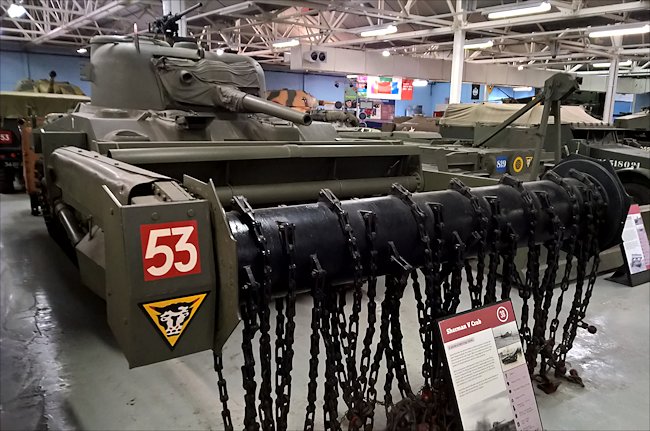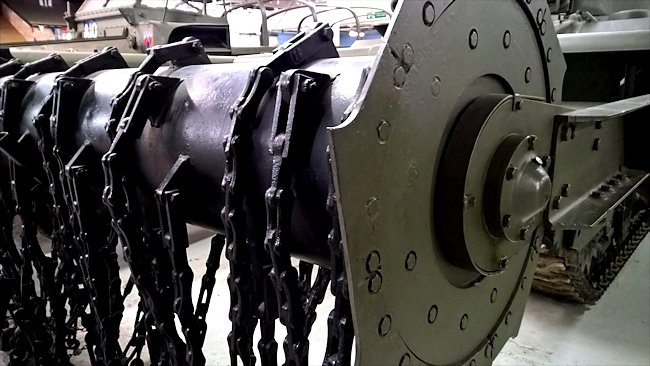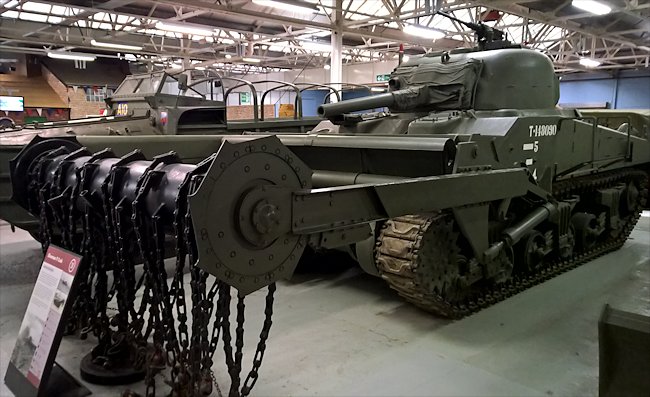Sherman MkV Crab Flail Tank
This preserved Sherman V Crab was a mine—clearing flail tank used during the invasion of Normandy on D-Day. It was one of Colonel 'Hobart's Funnies': specialist armoured fighting vehicles designed to do a particular task to assist the Allied forces gain a foot hold on the Northern French Coast.

Surviving Sherman Crab Flail Mine Clearing D-Day Tank of the Westminster Dragoons.
During World War Two the flail offered an effective solution to clearing safe paths through minefields. The cylinder at the front has chains attached to it and was turned by the tank's engine. When the cylinder turned, these chains struck the ground and set off any mines. Cutting edges on the ends of the cylinder cut through barbed wire which the chains pulled up.
When clearing mines, tanks operated in teams of five: three tanks flailing; two in reserve. The flailing tanks advanced in a dead straight line at 2 mph, clearing a broad path through the mines. Moving at this speed made them an easy target for enemy guns. The tanks were unable to use their guns whilst flailing, so the reserve tanks gave supporting fire. If a flailing tank was knocked-out a reserve tank took its place.
From D-Day onwards flails were operated by the 30th Armoured Brigade in the 79th Armoured Division. The Flail on display in the Tank Museum in Bovington is fitted to a Sherman Mark V Crab of the Westminster Dragoons.

Preserved Sherman Crab Flail Mine Clearing D-Day Tank
Panzerfaust rockets bounce off Sherman Crabs on D-Day
These are the memories of German Private Marten Eineg, 726th Infantry Regiment, 716th Static Infantry Division stationed near La Riviere on Gold Beach. - We saw a Sherman tank emerge from over the mounds by the ruined bunker, and this was an astonishing sight for us all. This Sherman was fitted with a revolving drum on the front held by two girders, on which were tied a large number of heavy chains. The drum was revolving, and the chains were crashing onto the earth with a deafening noise, raising clouds of dust and soil.
I had never seen a machine like this, but the officer shouted that this was an anti-mine vehicle, and indeed I saw several explosions under the chains as the tank came forward, these being mines that were being detonated. I was fascinated by its clever design, despite my apprehension. I could just see, behind the mine-clearing tank, two other Shermans also with these revolving drums, following it on either side; the lane they were clearing was thus about twenty metres wide.

Restored Sherman Crab Flail Mine Clearing arm.
One of the Panzergrenadiers fired a Panzerfaust but the range was too great and the rocket fell to the ground without striking. The officer shouted for us to hold fire, and said that the 75mm PAK gun was coming up to defend the slopes.
As the mine-clearing tanks came closer, the noise was incredible, and the pounding of the chains on the earth could be felt under us. Several times, a chain came loose from the spinning drum after a mine explosion, and the chain flew up into the air a great distance, and then came falling to the ground. One of these huge chains, which was about three metres long, fell in this way onto two of our men and knocked them both unconscious where they were crouching.
One of their comrades leaped up and aimed his Panzerfaust over the ridge, and the weapon fired, sending a jet of flame back behind it. I looked over the ridge, and saw the rocket head strike the revolving chains. the projectile was simply knocked up into the air and it went away across the slope. However, other men were stationed at the extreme ends of the ridge, and they were able to fire on the sides of this leading Sherman. The angle was acute, but they chose the target well, aiming the warheads at the wheels and tracks along the sides, and I saw the tank hit in its running gear.
There was a large orange flash, and suddenly the chain drum slowed, and then stopped revolving. The tank itself stopped completely, and smoke began to pour from the rear decks. Our other men did not need a second chance, and they aimed a Panzerfaust directly onto the Sherman's front now that the chains were still. The rocket struck the lower turret, which was turned to the rear, and blew a hole in it which disgorged sparks.
We thought that we had stopped this tank, but the machine gun in its front plate fired on us, shooting all the way along the ridge and blowing out puffs of earth wherever the bullets hit. Also, the two similar tanks behind it came level, and continued to advance, even though that leading tank was now burning.
By this time, we had about a dozen able-bodied troops left on this ridge, including myself and the officer. We had no Panzerfausts left, but the PAK gun then arrived, towed behind a Hanomag armoured half-track which used the cover of a hedgerow. This was a large 75mm PAK gun, and the crew flew into action like devils, hauling it around and positioning it on one side of the ridge where it could fire down the slopes.
The Hanomag had an MG in a shielded mount too, so we were now better armed. The PAK crew began firing within a minute, I was astonished at their speed. They immediately hit one of the two mine-clearing Shermans, striking it on the revolving drum. The drum separated from the vehicle, and crashed off onto the ground, while still revolving at high speed. This great metal cylinder raced off among the dunes, sending out bits of chain and debris that flew long distances on both our side and the English side.
The tank was undamaged, though, and it halted and began to traverse its turret around onto us, moving the main gun around very quickly. Our PAK fired again, but the round deflected off the angled front plate and went off to one side. The PAK fired another shot, and this one struck the Sherman in the tracks, causing the drive wheel to break off and spin away.
However, although this tank was now immobile, its turret was fully rotated onto us, and it fired on the PAK, using high explosive. The shot went wide, but the blast lifted the gun up and rocked it and the crew then struggled to operate it. They worked on it like devils with their hands, but nothing came of it. The Sherman fired again, and this round hit the PAK crew directly.
This was a dreadful sight, because much of the 75mm ammunition also exploded, and the debris was blasted out all around us. The Sherman continued firing, and it landed high-explosive shells on the farmhouse, which began to burn, and on the ridge which we were sheltering behind. Some men shouted that we should surrender, but the opportunity to do this was not there, as the Sherman kept firing all along our line. A moment later, a handful of English troops emerged from the path, with their bayonets fixed or with Thompson guns. We were over run and surrendered.
Where can I find other preserved Sherman Crab Flail Tanks?
- M4A4(75) Crab - National War and Resistance Museum, Overloon, Netherlands, Holland
- M4A4(75) Crab - The Tank Museum, Bovington, England
- M4A4(75) Crab - Westkapelle, Netherlands, Holland
- M4A4(75) Crab - Yad la-Shiryon Museum, Latrun, Israel
- M4A4(75) Crab - Armoured Corps Museum, Ahmednagar Maharashtra, India
- M4A4(75) Crab - MCEME Parade Grounds, RSI Institute, Alwal, India
- M4A4(75) Crab - Pakistan Army Museum, Rawalpindi, Pakistan
- M4A4(75) Crab - Canadian Forces Base, Borden, Canada
- Source - Pierre-Oliver Buan - http://the.shadock.free.fr/Surviving_Panzers.html
Read more accounts in these books

